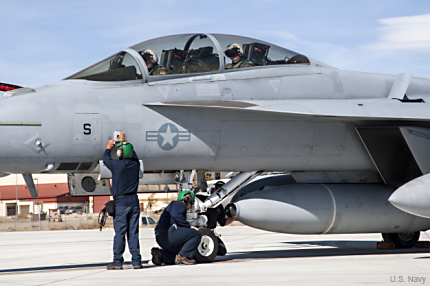Airborne infrared targeting sensor passes key milestone
The Navy’s Infrared Search and Track system can track heat sources from long rnage while avoiding detection itself.

The IRST targeting pod was mounted on an FA/18 Super Hornet during flight tests earlier this year.
The Navy’s Infrared Search and Track (IRST) system, designed to identify and track heat sources from the air while avoiding detection itself, is ready for low-rate initial production.
The air-to-air sensor, seen as an important tool in the electronic-warfare environment, has been given Milestone C approval and will be integrated into the Naval Air Systems Command’s F/A-18 Super Hornet, NAVAIR announced. The IRST pod, being developed by Boeing and Lockheed Martin as part of a $135 million contract awarded in 2011, can track multiple targets at extended ranges under both normal and electronic attack conditions.
And as a passive system that uses long-wave infrared, as opposed to radar, it does not emit radiation, making it hard to detect. The pod is mounted inside a centerline fuel tank, so it doesn’t require any modifications to the Super Hornet’s frame.
Amid growing threats from electronic warfare, the Navy was looking for an alternative to radar systems that can be disrupted by devices such as advanced digital radio frequency memory jammers.
"Integrating the infrared pod onto the Super Hornet revolutionizes how we fight on a networked battlefield,” Capt. Frank Morley, manager of the PMA-265 Program Office, which is managing the program with NAVAIR, said in a statement. "IRST advances the Super Hornet's role in air-to-air combat operations, keeping us ahead of our adversaries in an evolving threat environment."
The Navy first tested the system earlier this year at Edwards Air Force Base, Calif., and plans further tests of IRST’s capability, stability and safety before moving to initial operational capability.
NEXT STORY: Army to go solar at Redstone Arsenal